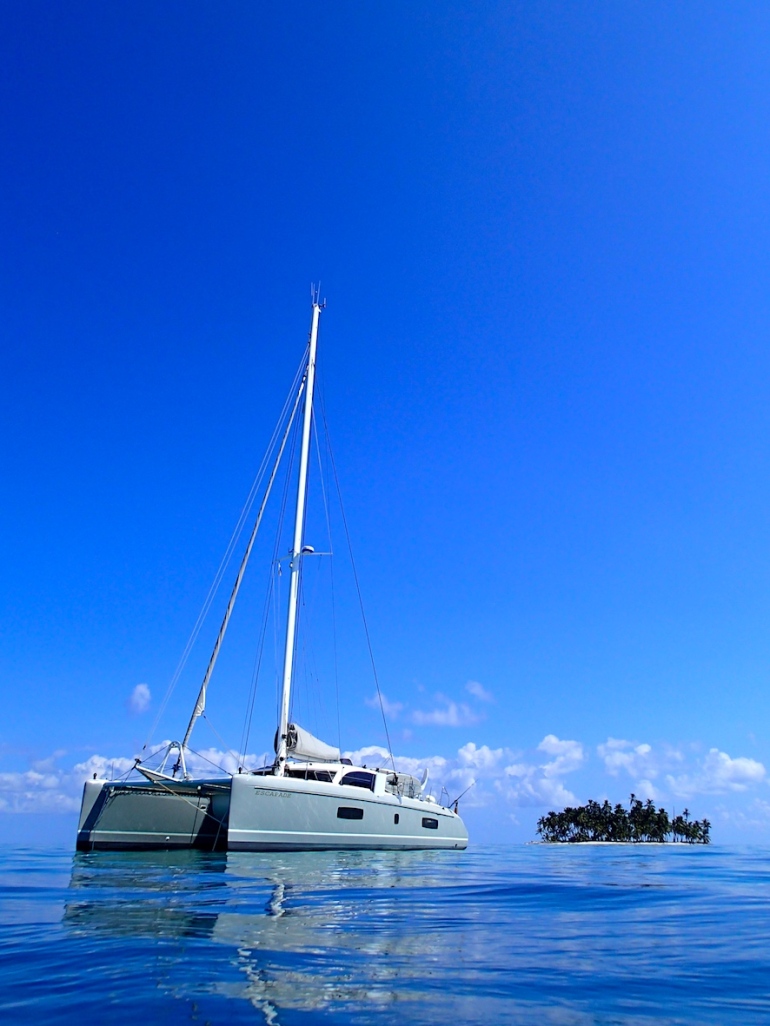
This is turning into a very lazy, low mileage winter.
We sailed in to the Guna Yala 4th January and we’re still here. Since then we’ve probably sailed about 300 miles in short hops between islands. Last winter we sailed 4,000 miles, this year we might do 1,000.

Weeks go by with the anchor buried in white sand, there’s weed growing on the props!
What are we doing with all that time? Well here’s the notes from the last few weeks..




Learning the Guna language:
Since we have been in the San Blas area, we have visited islands with the following names:
Acuadup
Banedup
Uchutupu Dummat
Uchutupu Pipigua
Nargana Yandup
Gusebgandup
Nuinudup
Niadup
Misdup
Nasargandup
Kagandup
Naguarchirdup
Kalugirdup
Kuarsurdup
Ogopukibdup
Iskardup
Sugardup
Salardup
Yansaladup
Waisaladup
Eggsaladup
Greeksaladup
Thisendup
Ok I made up the last three, just to see if you were paying attention, but the others are all what the Guna consider sensible names for islands.
Not only are the names tricky to read in the small print of the pilot book, or pronounce, on the VHF radio for example, but at some point they ran out of special Guna names for islands so they started re-using them. There are three Banedups, two Tiadups, two Waisaladups all miles apart from each other in separate archipelagos, which only adds to the navigational challenges.
Then some islands also have an unhelpful Spanish name, like Coco Alto. Great, there are 400 islands here and they all have high coconut trees.

We are picking up a few words of the Guna language, ‘Dup’ as you have probably gathered, means island. A baby is a ‘mimi’ and a butterfly is a ‘chuchu’. As you can see, we are practically fluent.
Then there is the salutation to the whole hut just before you drink your chicha: “Ito malando!” Which was translated for me as ‘Let’s feel this!”. (Very appropriate, see previous post.)
The most useful Guna word is ‘Nuedi’ (Noo-weh-dee) which means Good Morning, Hello, Goodbye and Thank you. A one-stop phrasebook, “Nuedi!”.

Heart rate research:
You may recall that we did a free diving course in Bonaire last year. (See blog post: Feb 2016) Since then we have been practising the art of diving on a single breath and now I regularly enjoy relaxed descents to 15m (50ft) staying at depth for a minute or so quite comfortably. It doesn’t sound long but it’s a special time down there, partly because I still can’t really believe I can do it. Two years ago I could not have made that dive any more than I could have levitated above the water.
The interesting thing is that it’s much easier to hold your breath at 15m than at 5m. I referred before to the ‘Mammalian dive reflex’ which is a series of physiological responses to deep diving shared by dolphins, whales, sea lions and humans.
Blood flow is directed from extremities to the heart, lungs and brain, and heart rate is reduced to conserve oxygen and allow for longer dives. I’m fascinated by this.
My new dive watch displays my heart rate, transmitted from a chest belt. I have started checking my heart rate, much to Dawn’s amusement, at different times of the day as I potter about the boat. When I first wake up in the morning, it’s usually about 55, normal walking around about 75, swinging in the hammock 60ish, snorkelling along on the surface maybe 85. Winding up the dinghy winch, 95.
On a good dive, I am hanging motionless in the blue world, 15m down, watching the fish go by. The surface looks to be an awfully long way up, I’m in an alien environment. The pressure down here is 2.5x that at the surface. My lungs have been compressed and are now less than half the volume they would be at the surface. My buoyancy is neutral, or negative, I can free fall. This should be a threatening, stressful experience, but I am calm and comfortable, my movements are sloooow, I am smiling.
My heart rate is at 45, that’s less than when I’m sleeping.

Windsurf daydream
We are anchored in your average pristine San Blas lagoon, the view is a variation on the usual composition of white sand island and swaying coconut palms. Water in shades of blue and green indicating depths like contour lines on a chart. The occasional dugout ‘ulu’ is paddled over by smiling Gunas to sell us their catch. All the splendour we have come to expect from a San Blas anchorage. But this place also has a nice righthand wave peeling down a reef about 200m from where we sit. I watch it all day, sometimes glassy, sometimes with 15kts blowing down the steep wave faces. Sometimes with a few surfers on it from our neighbouring boats, their dinghies anchored at the shoulder.
When it’s time to windsurf I rig on the trampoline, throw board and sail over the side and swim it the 30m to the wind line. Then it’s a 2 minute sail to the reef. Colourful corals beneath the board, a bit shallow in places but all do-able, and the bigger the wave the deeper it breaks.

This is a windswell wave. We’re at the western end of an 1,100 mile fetch of Caribbean, and upwind of that, 3,000 miles of Atlantic. That whole area of water is blown by NE trades all winter, so there are plenty of waves, no waiting around for a groundswell. That windswell pounds the reef upwind of us, a constant ambient noise day and night, but as the waves reach our island, they bend around 90 degress and start to form up into walls and troughs as they approach the reef. Perfect wind angle.

The waves are slow moving, with a short period, and never huge, but there are sets every few minutes which are easy to spot and significantly larger than the rest. After a few sessions here it’s easy to be in the right place. Some times it’s too easy, my lap is perfectly in sync: sail out, see a set, tack into the second trough, sail it back in to the reef, drop in and ride down to the shoulder, gybe back out to the zone, oh here’s the next set! Repeat until next mealtime.

The best rides start on the first peak, or just upwind of it, the choppy hump moves over the coral shelf and becomes smooth and hollow, steep drop, that peak can throw it’s lip. Time that turn right and you may get two or three more good hits as the wall stands up to meet you. The ride ends back in the colourful coral shallows, I look back and see Escapade so nearby, I described this place to Dawn as my windsurfing daydreams come true.
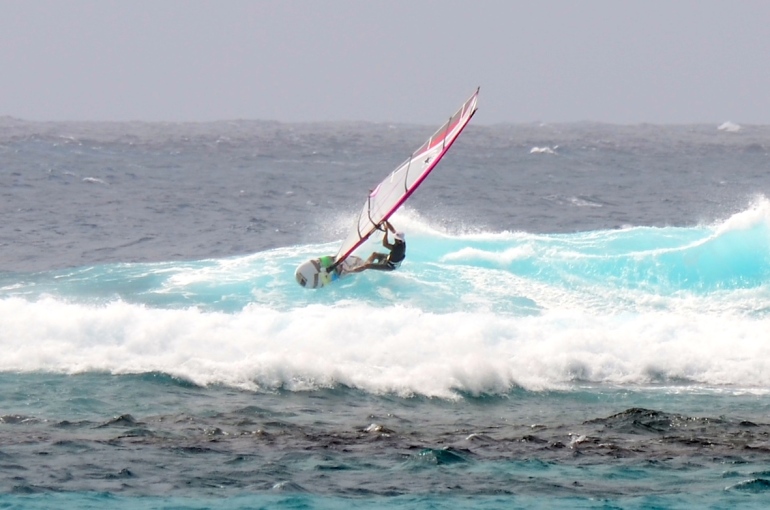
Fishing at anchor
We generally troll a lure while underway, as long as the sea’s not too rough or we’re sailing too fast to deal with a fish fight. But what about all this time we’re sitting at anchor watching fish jumping out of the water?

Recently I’ve been trying to catch fish from a windsurfer. I troll a lure at slow speed from a big inflatable board with a small sail. The lure is on the end of a 30m line wound on to a plastic yoyo. If a fish takes the lure, the yoyo will jump off the back of the board and drag in the water, towed by a loop of elastic shock-cord, which is clipped to the tail of the board. I also carry a glove and lump of wood to deal with the catch, and a bag to bring it home in. Great system, but I haven’t caught anything yet. I have tried different lures at different speeds, plus strips of fish bait. I have towed that baited hook right through the fishiest patch of water you could hope for, with fish jumping around the board! Nothing.
A Guna sold us a brace of octopus which we killed, gutted, tenderised and stewed in their own juices. Delicious. I had a few scraps which seemed perfect for bait. The first scrap was dangling over the side at sunset last night when it produced a nice size snapper. This morning I tried again with another scrap. Soon the clicker was calling and the line was running off the reel. We jumped up to see what was for dinner. Not a pan-size snapper, but a 5′ shark.

The commercial awakening of the Guna
I said in a previous post that we were so surprised to see the traditional Guna lifestyle was still intact in the Eastern villages near the Colombian border.
The Guna Indians have chosen to live in a very simple economy, little changed in generations. The Guna diet of fish, seafood, coconuts, plantains and fruits are all supplied as they always have been, with no exchange of money. The women paddle a canoe to their fruit trees on the mainland each morning, the men hunt for fish and lobster.
Now a Colombian trading boat chugs in to the village every so often carrying things like toothpaste, cans of salchichas and beans. They trade with crafts, crops and seafood. Until recently the coconut was a sort of currency, now replaced by the Dollar.
Guna women sew elaborate molas to sell or exchange.

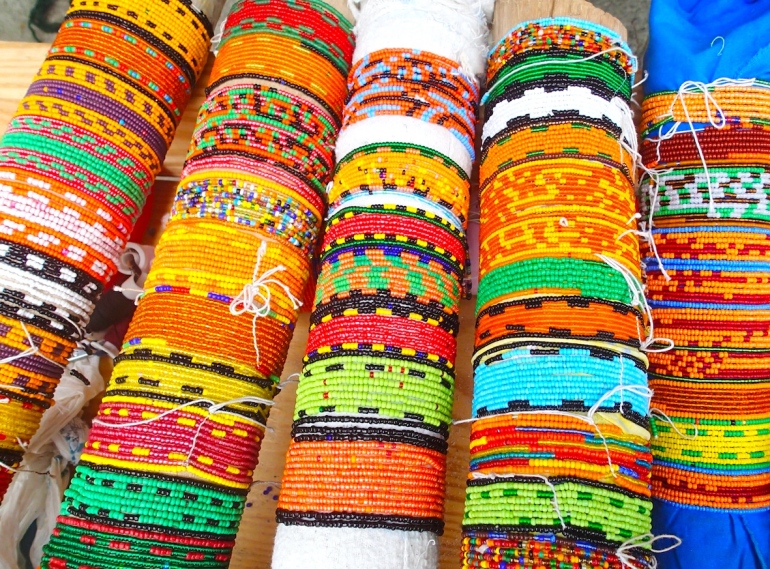

Here in the Western San Blas change is coming fast. So if you’re happy to sell a mola for $10, there may be a hundred of hours of work, you’re working for $0.10 an hour?
A couple of good divers in a dugout can easily collect 10 lobsters in an hour, they sell them to the happy yachties at $5 each and paddle home with $50 for a morning’s work.
But it’s not just dropouts in their sailboats that want to be here. One aerial photo of these islands will sell a thousand excursion tickets in Panama City. Day trips to paradise!
So a few enterprising Gunas have got some fibreglass fishing pangas, adapted them for passenger trips and started their own tour operations.

But now these little desert islands need facilities for the tourists, concrete toilet blocks, some kind of a bar (beer cooler with a solar panel) The latest thing is ‘hotels’, now you can stay a night or two on a remote island, sleep in a hammock in a thatched hut with a solar lamp. Last year $50 per night, now $100.

A society that managed to live in the modern world without money for so long, has discovered capitalism, we’ve seen the ‘before and after’ here and it feels like a loss of innocence, but who can blame them? The new generation want Yamaha outboards, fibreglass boats, cellphones and solar power to charge them. Tourist dollars will buy that.
Yachties who have spent a lot of time here say it is already unrecognisable from two years ago. What will have developed 5 years from now?
It’s the old story: When’s the best time to go to the San Blas Islands?
Ten years ago.

Award Winning Blog!
We started writing this blog to avoid sending long, repetitive emails to family and friends. We don’t have a huge audience but the blog has followers around the world and we are grateful for all the comments and feedback.
Many thanks to the Royal Channel Island Yacht Club in Guernsey who have awarded us their prize for ‘Cruising Blog of the Year 2016’.
Guernsey yachtsmen have an amazing cruising ground of their own. The glorious Channel Islands and the French coast so near, but sadly they also suffer from a long cold winter, or so we have heard.
Anyway great to know someone’s reading this back home!

Some more moments from the last few weeks:

Preparing an ulu for the annual sailing races. Crew seems to be one strong man steering with a big paddle as a handheld rudder, one man forward with main and jib sheets, one boy amidships bailing furiously.

Traditional lifestyle plus iPad phone calls.
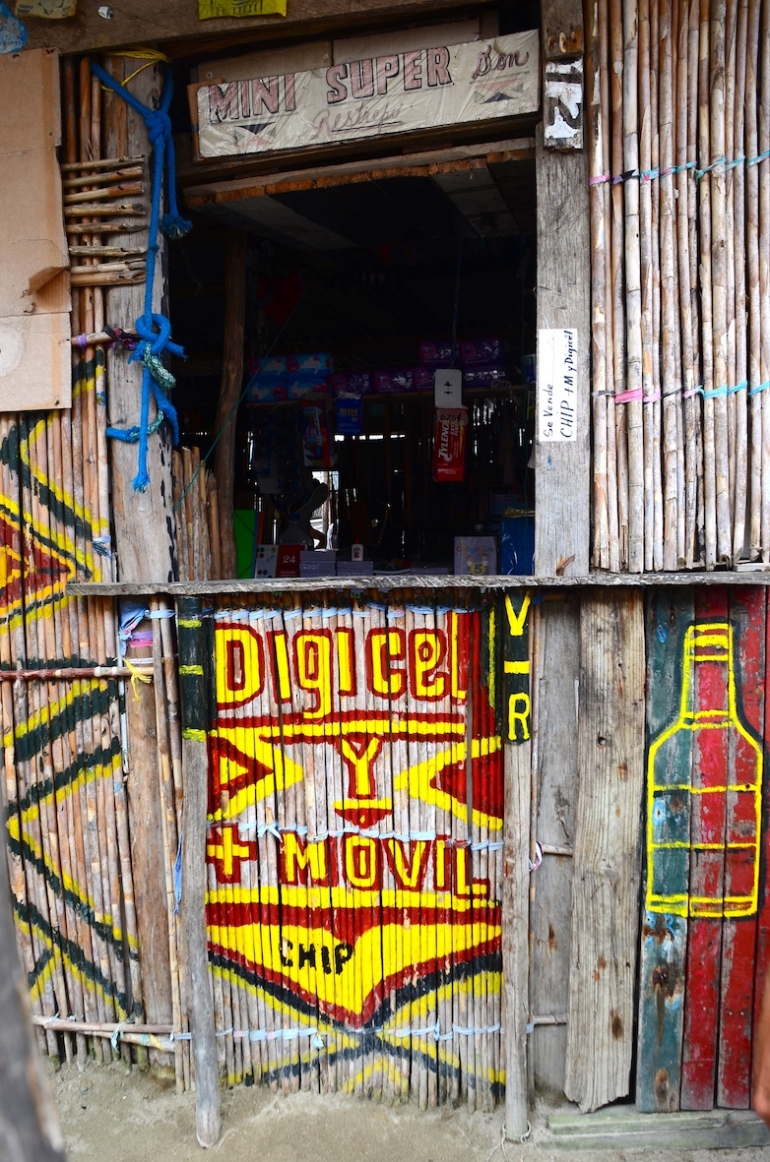
The cellphone store.

An alternative Guna view of the sunlit coral gardens around their islands.

The man who lived here was a specialist hunter. He used to go into the jungle to stalk tapirs, returning with meat for the village.
He died recently and now there are no more tapir feasts on the island, but these are still hanging outside his hut.
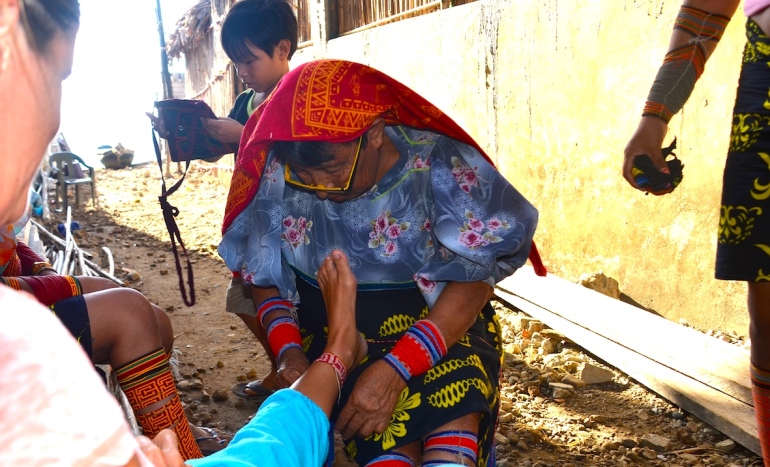
Dawn goes Guna.


It’s not all beer and skittles on Escapade you know, the daily grind of chores is never over..
Laundry day

The weekly food shopping



Fishmongering

Keeping in touch with the world

Scoping the next anchorage

Etc..
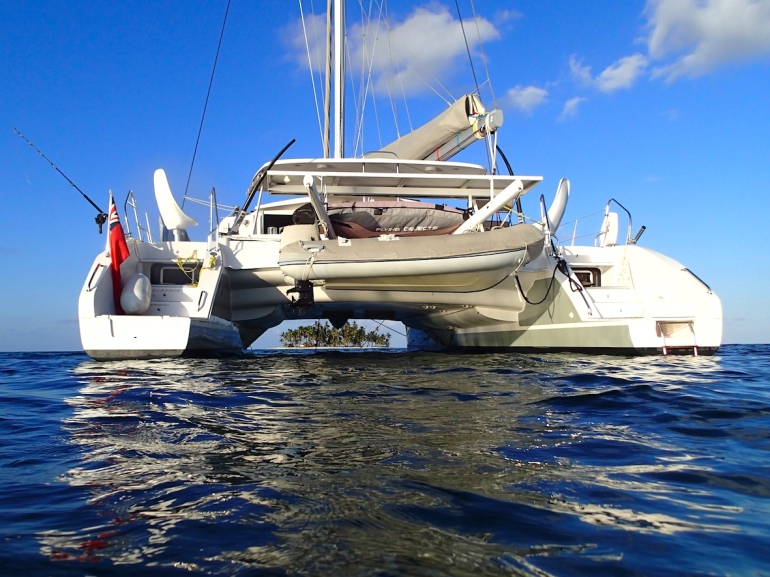

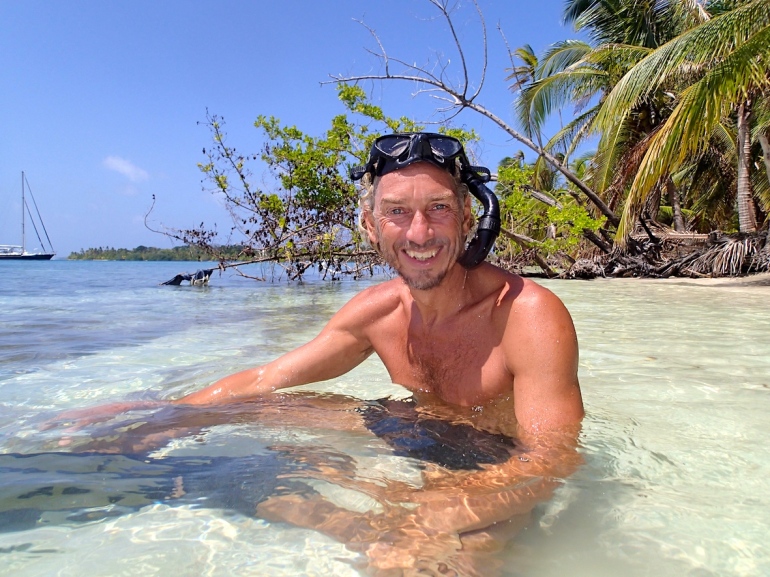



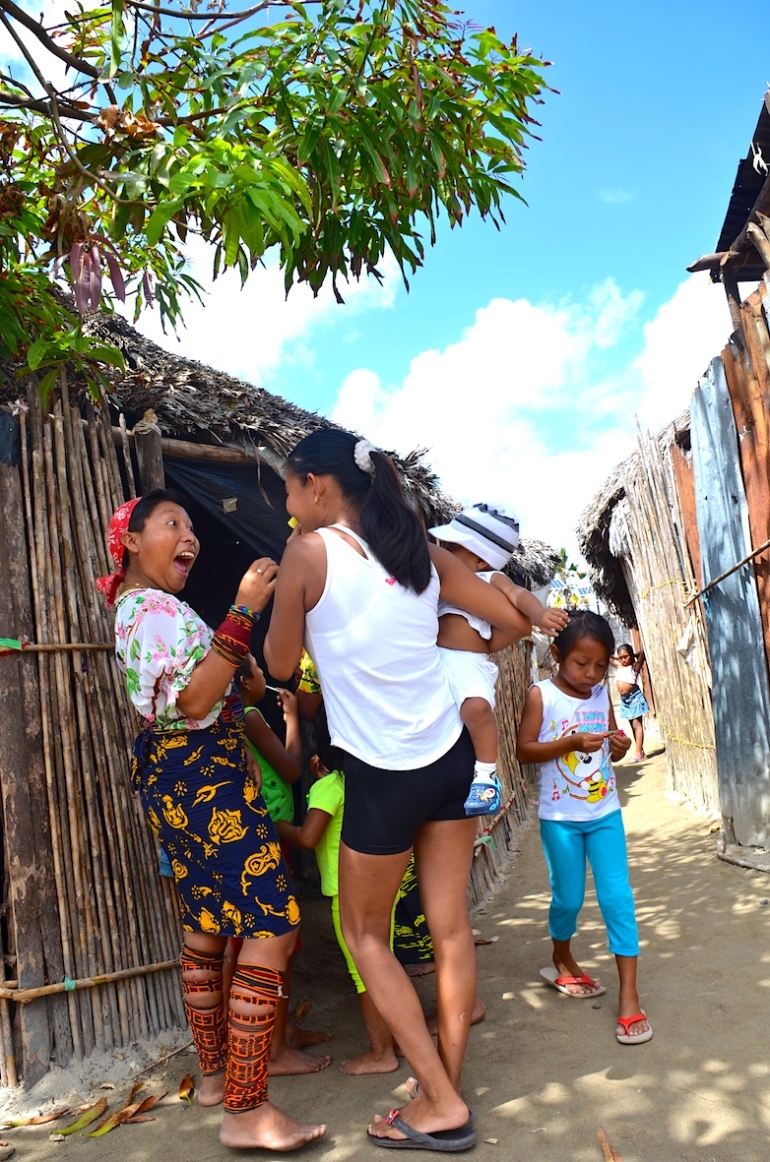

looks EPIC >
LikeLike
how enchanting, peaceful …
LikeLike
Wonderful photos.You really are living the dream.Enjoy every minute of it.Out in Spain with the boys last month.They send their love
LikeLike
Love this guys. X
LikeLike
What a trip! Missing you both lots, enjoy every single second xxx
LikeLike
Why move on when you have everything there, was there not an island called Cheesenibbleup…? 🐭 would of loved thats😉
Looks amazing😍Xx
LikeLike
Beautiful!!! Enjoy hearing about these less discovered places and so wise to enjoy it now before it changes!
LikeLike
I seem to have used up all words pertinent to your current lifestyle in previous comments……so ditto!! Love to you. Mouse
LikeLike
Amazing photos!
LikeLike